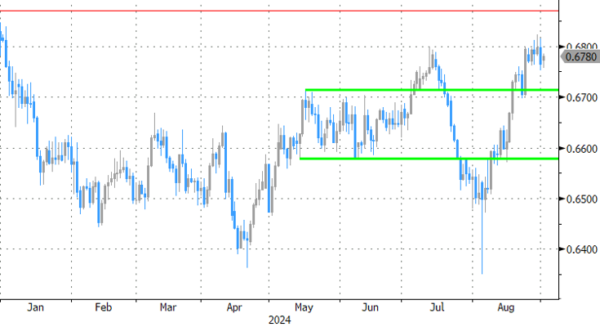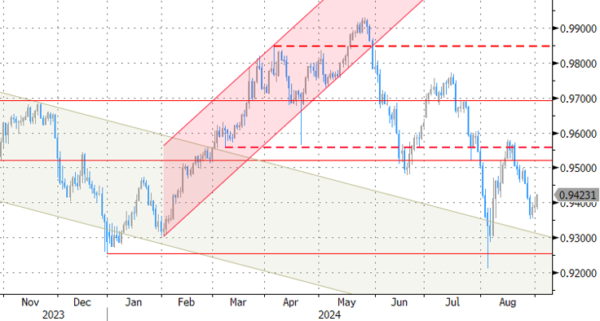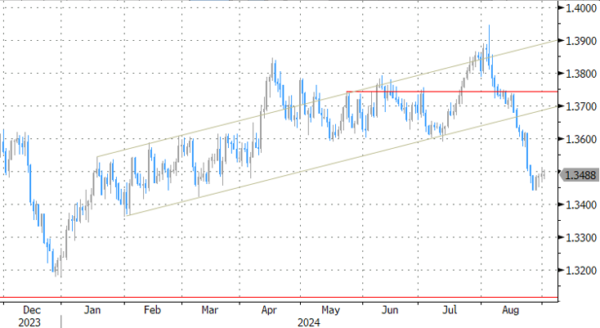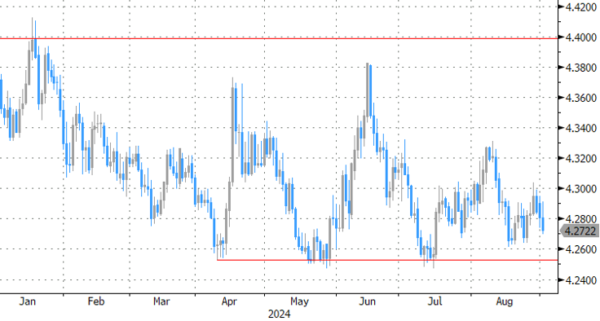Markets
Trading slowed down to a trickle today in absence of US investors (Labour Day holiday) and amid an empty EMU eco calendar. A lot of ink has been spilled about this week’s key US eco data and their impact on markets and Fed policy. It allows us to have a look at this week’s alternative agenda, starting with Swiss eco data tomorrow. Swiss inflation is expected to continue hovering just above the 1% Y/Y mark as it has been doing all year long now. Simultaneously, Q2 GDP growth is expected to be confirmed at a solid 0.5% Q/Q. The Swiss National Bank already in March took conform of inflation being under control, allowing for a scaling down of policy rates. They followed-up on the action in June and we expect them to do so again in September. Despite their relatively early start and pace, the SNB desperately sees the Swiss franc strengthening further. Since the mid-July global market correction, EUR/CHF dived from 0.9750 to 0.9415 currently with a temporary stay below 0.93 early August. The relatively scarce SNB maneuvering room and the global swing towards less restrictive conditions suggest that CHF might remain stronger for longer and stronger than the SNB wants to. Brazilian GDP figures are worth watching as well tomorrow. Consensus expects another strong 0.9% Q/Q on the heels of 0.8% growth in Q1. Such outcome will cement rate hike expectations by the Brazilian central bank. It’s an example of what might be next if you achieve a perfect landing from a central bank point of view. Emerging markets were first to respond to the post-lockdown inflationary pressures, leading global central bank reaction functions by at least a year. The BCB started making policy less restrictive in July of last year. The current policy rate is 10.50% compared with a peak rate of 13.75% but way above the pre-pandemic 6.5% or 2020-2021 bottom of 2%. And the next move will be up instead of down. On Wednesday, we circle central bank policy meetings in Canada and Poland. The Bank of Canada is expected to implement its third consecutive 25 bps rate cut to 4.25%. We don’t think the central bank will be tempted into pushing through a larger 50 bps rate move as it would make the gap with Fed policy and key trading partner US too large. Ahead of the August market repositioning, USD/CAD was bumping into the 1.39 resistance area (weakest CAD-levels since 2003 with exemption of brief spells in 2015 & 2020). The National Bank of Poland will keep its policy rate steady at 5.75%. Apart from 100 bps stealth easing around the time of Polish election in September 2023, they stuck with restrictive policy settings unlike for example their Czech and Hungarian counterparts. NBP governor Glapinski for a while suggested that steady rates would last until at least the end of 2025. During summer, he started making an opening for a faster regime change. Upside inflation risks are subsiding and the reaction of Poland’s trading partners should also be kept in mind. Once the NBP officially changes its forward guidance, the Polish zloty could move away from the bottom to the top of this year’s EUR/PLN 4.25-4.40 trading range. Finally, on Thursday there’s a keynote speech by Reserve Bank of Australia governor Bullock to the Anika Foundation, a charity funded by money market participants. The RBA for now stuck with its peak policy rate of 4.35%, defying global cutting pressure. RBA members indicated that this could remain the case with inflation being a bit stickier than elsewhere. The central bank even remains vigilant to upside inflation risks, not ruling out another rate hike and calling thinking about RBA cuts as being premature. In light of recent strong labour market data and higher CPI, it will be interesting to see what tone Bullock’s speech has. AUD/USD is testing the recent highs near 0.68.
News & Views
The Turkish economy unexpectedly expanded by 0.1% q/q in Q2 of the year. That’s better than the 0.5% decline consensus was braced for but came along with a material downward revision to the Q1 figure from 2.4% to 1.4%. Turkish GDP is 2.5% larger compared to the same period last year, marking a slowdown from the outsized 5.3% in Q1 and missing a 3.2% estimate. The Turkish Statistical Institute noted household consumption increased by 1.6% y/y while that from the government rose by 0.7%. Capital investments were 0.5% higher y/y and a sharp -5.7% drop in imports vs flat exports resulted in a positive contribution from net exports after all. The economy treading water after a pre-election (March local elections), consumption-fueled Q1 suggests the more restrictive monetary policy is starting to filter through. With policy rates at 50% and inflation at >60%, real rates remain deeply negative though – even in case tomorrow’s inflation numbers print the expected major drop towards but still above 50%. That means there’s little room for the central bank to take its foot off the brake for the time being. The Turkish lira eked out a tiny gain against the dollar today. USD/TRY dips just south of the all-time highs around 34.
Graphs
AUD/USD: a vigilant RBA supporting the Aussie dollar
EUR/CHF: Swiss franc stronger for longer and stronger than SNB would like to see
USD/CAD: Loonie was testing multiyear lows ahead of August USD pullback on diverging monetary policy
EUR/PLN: a change of tone at the NBP can propel the pair from the bottom to the top of this year’s trading range

















